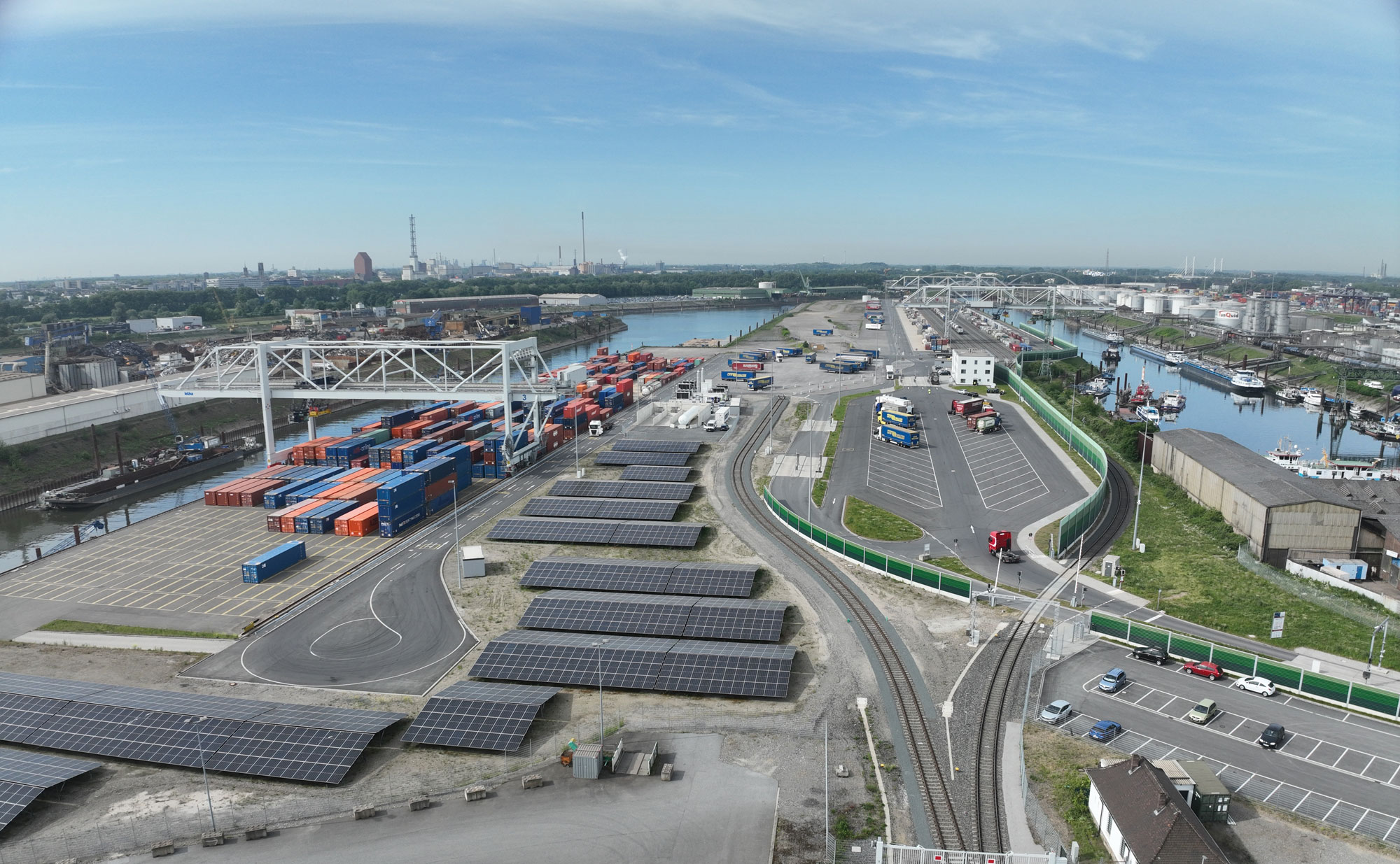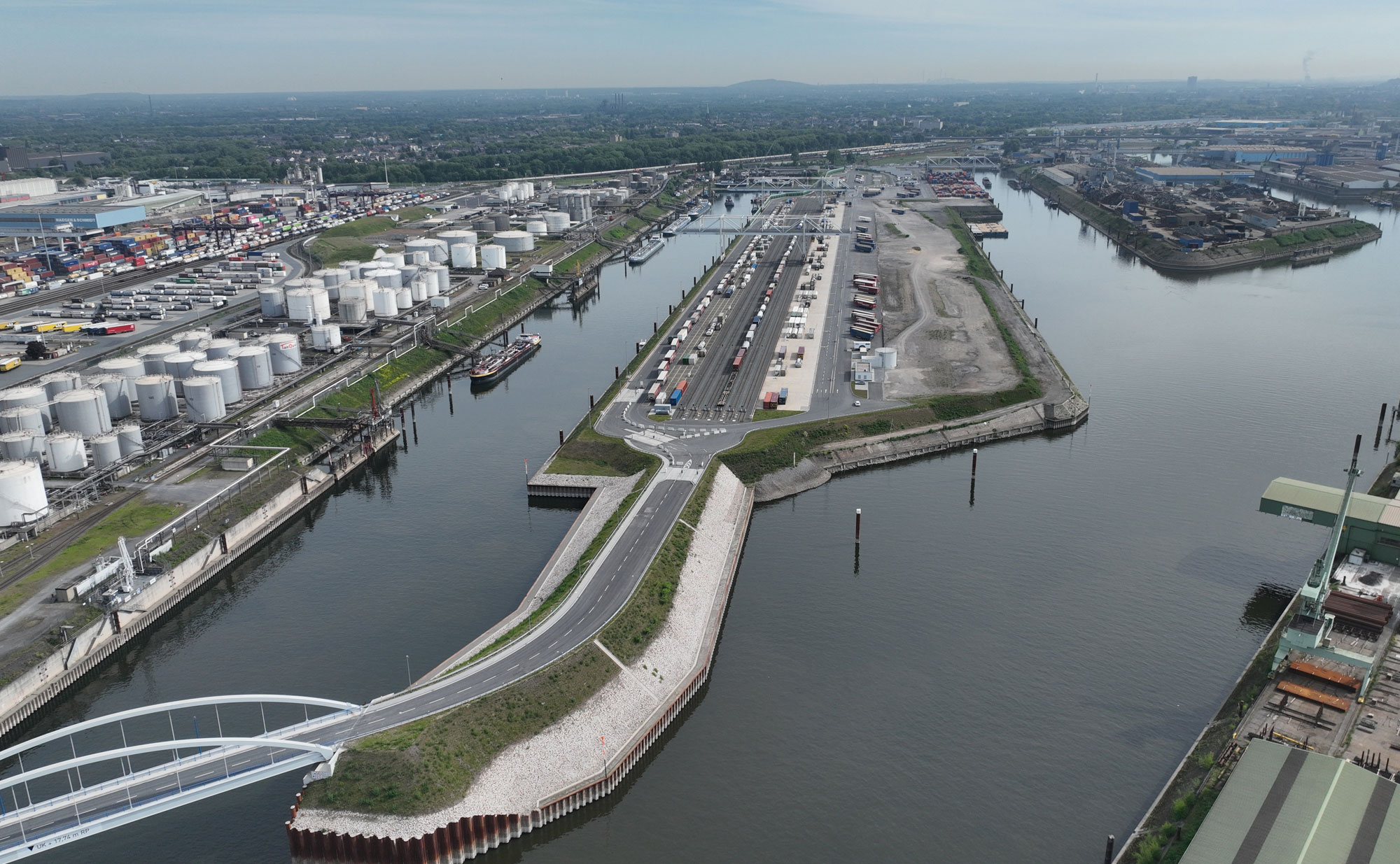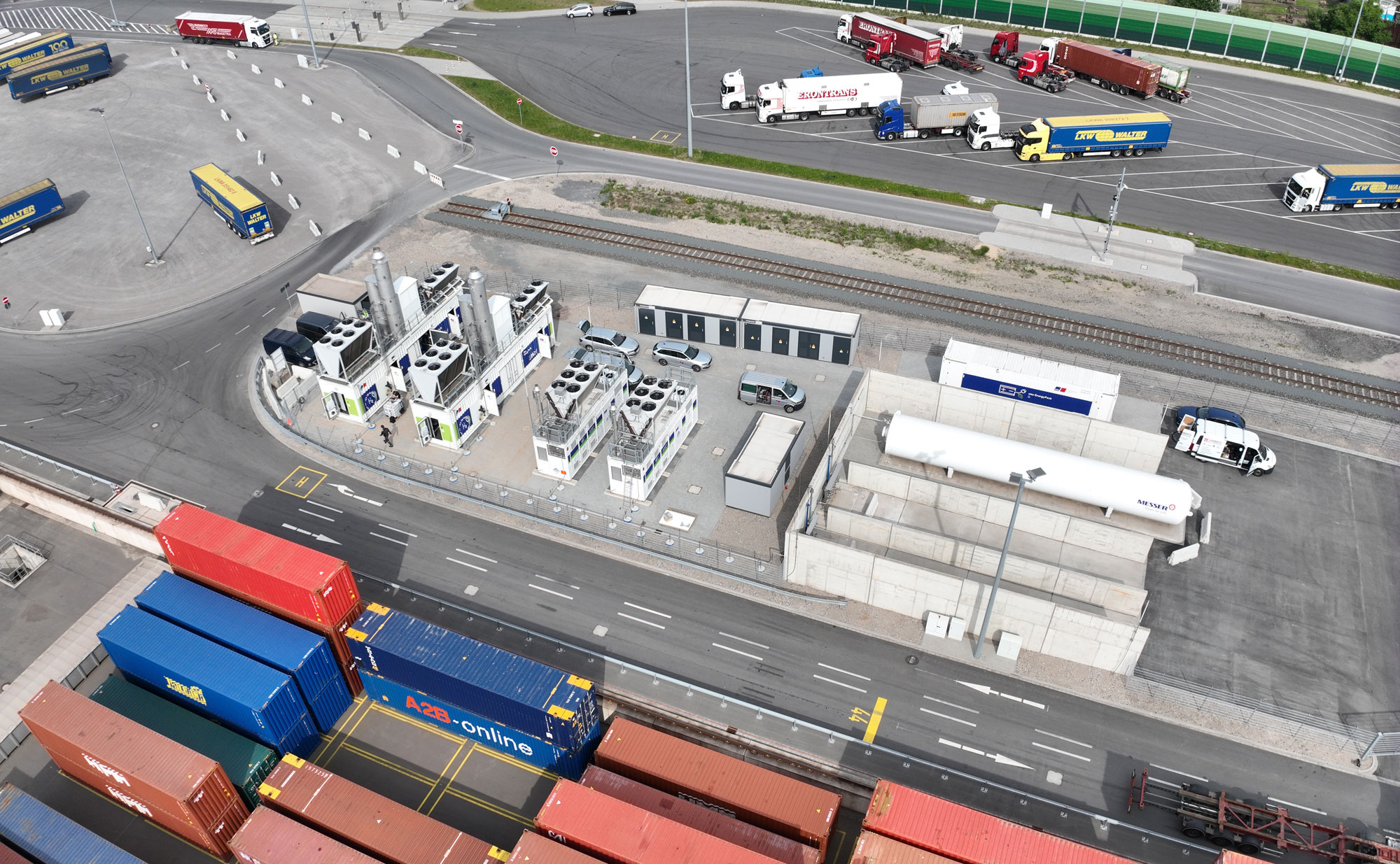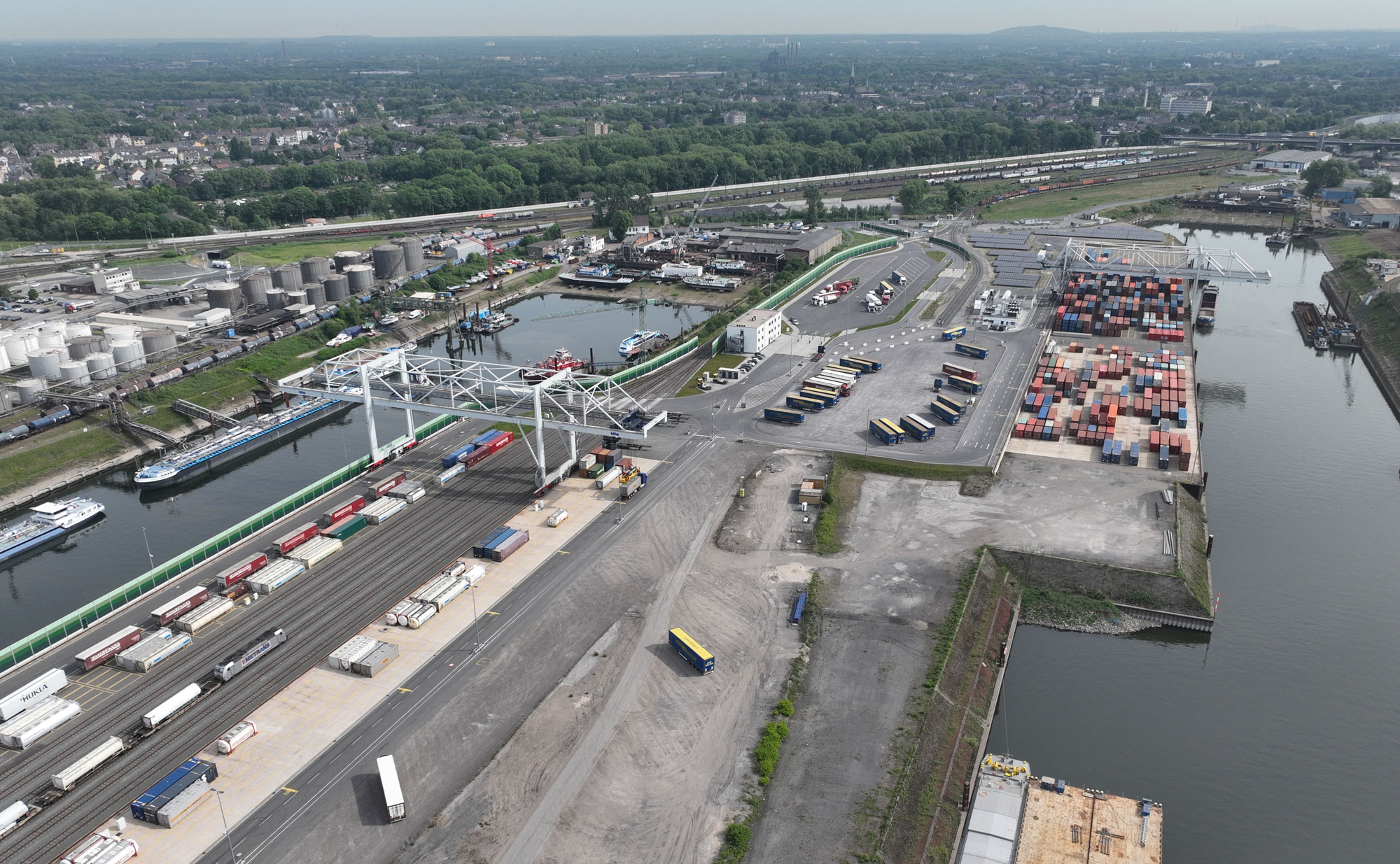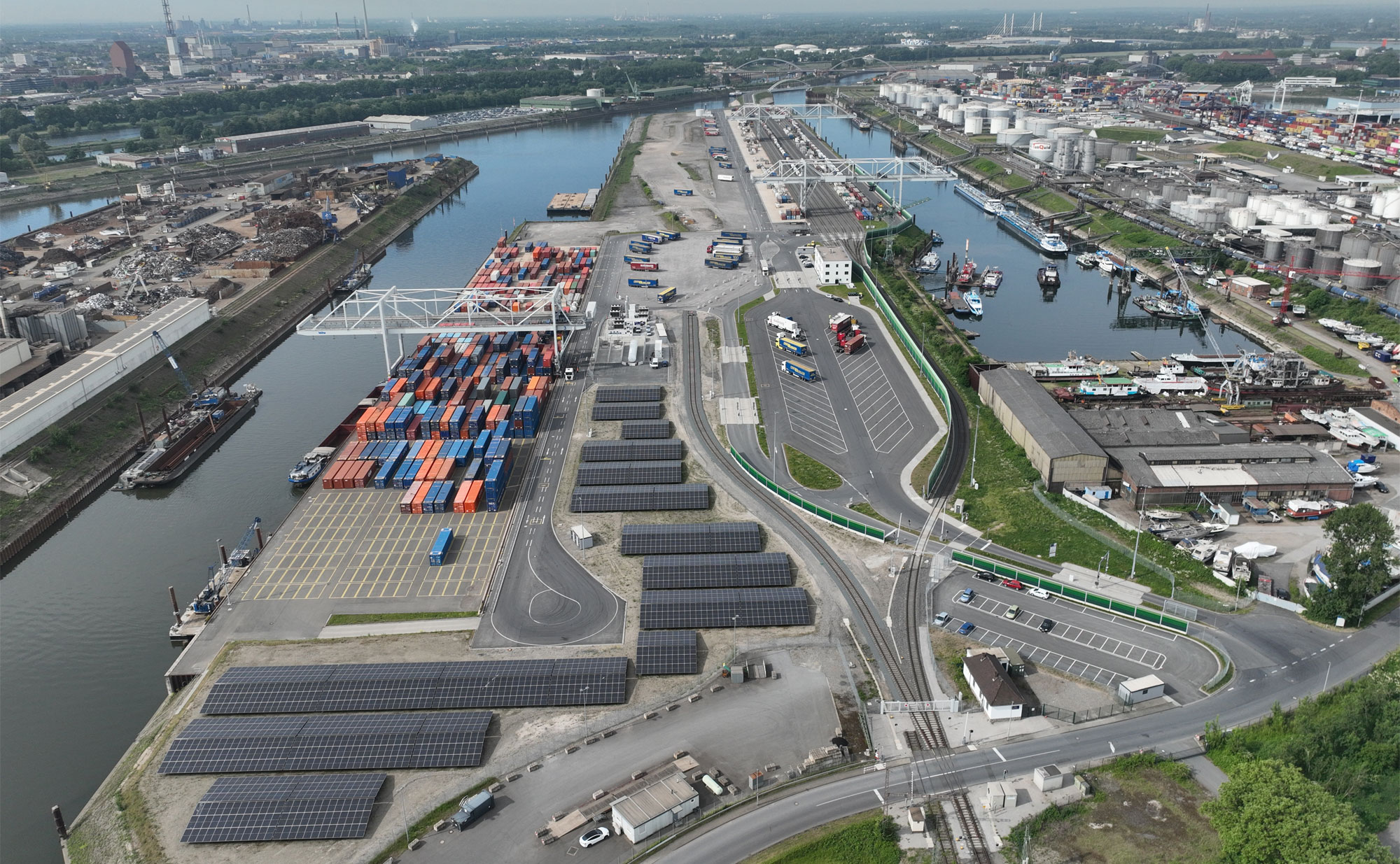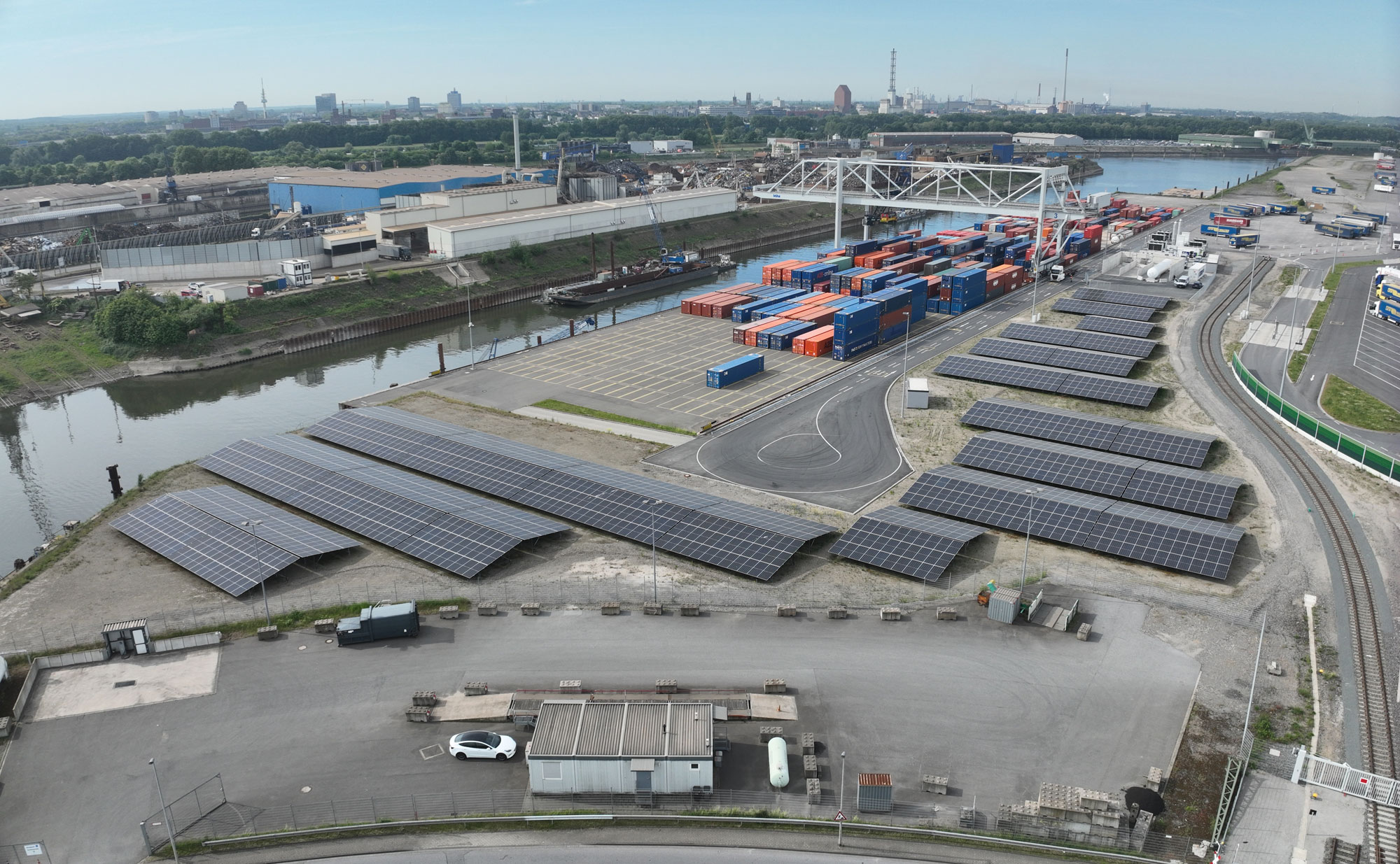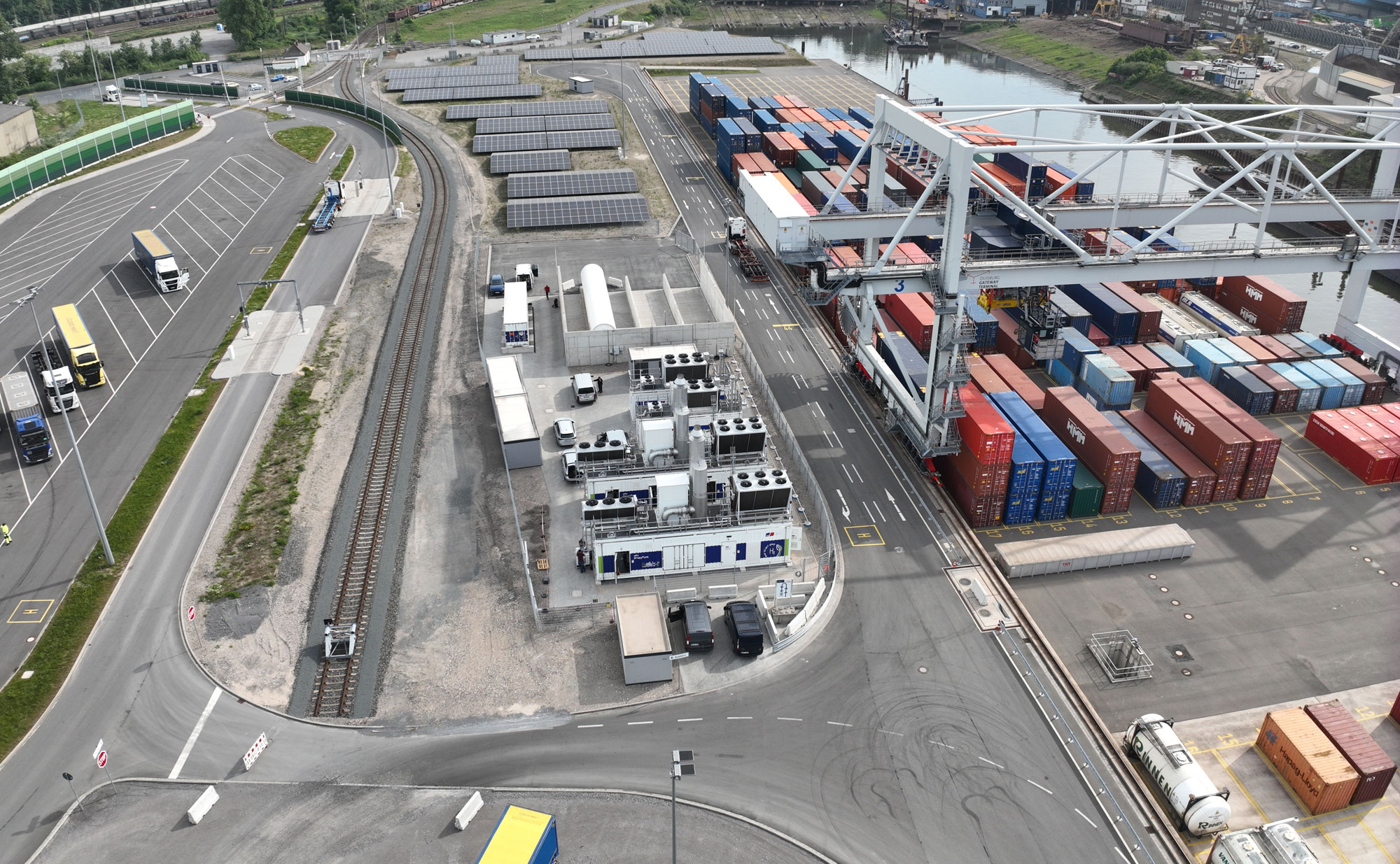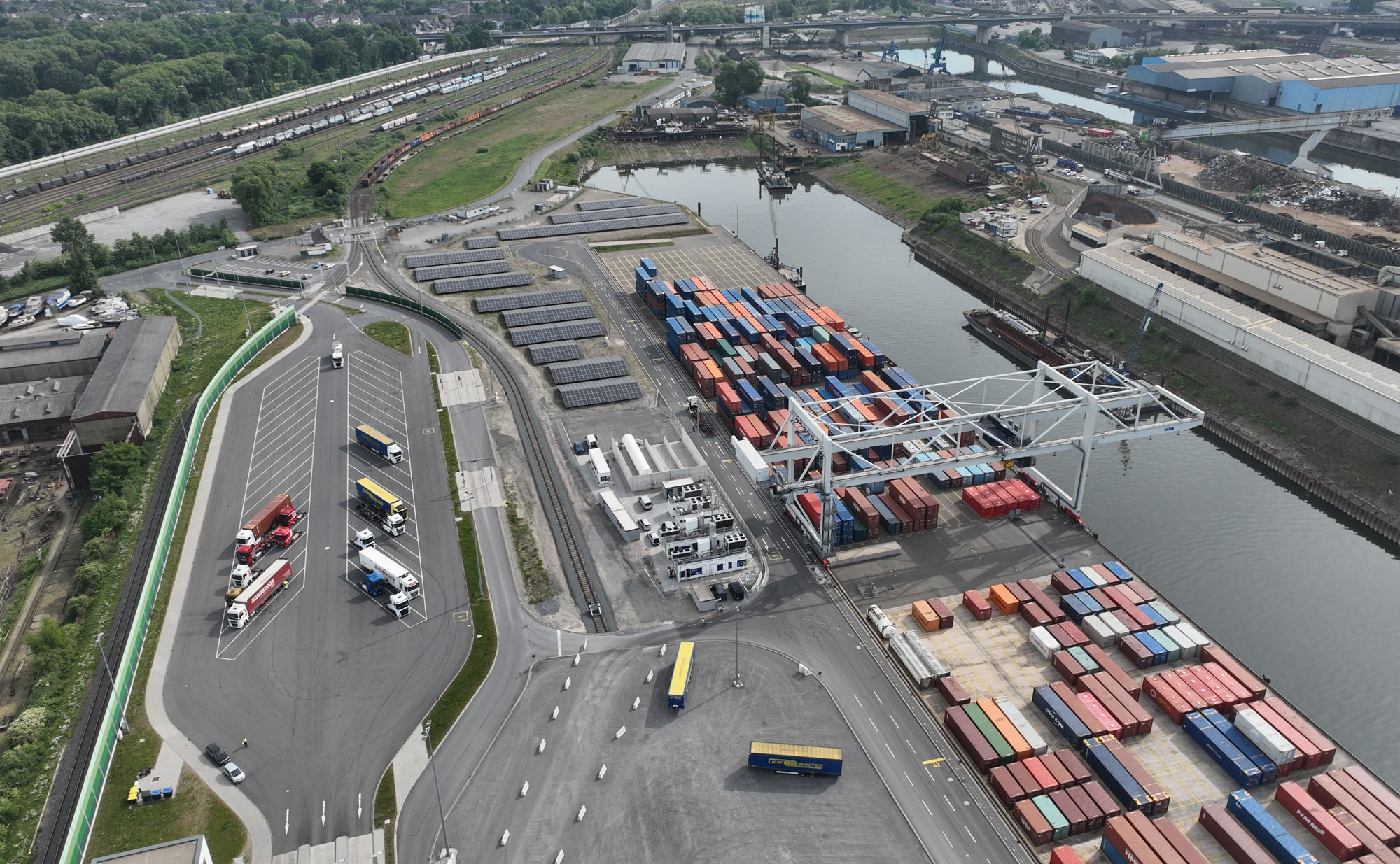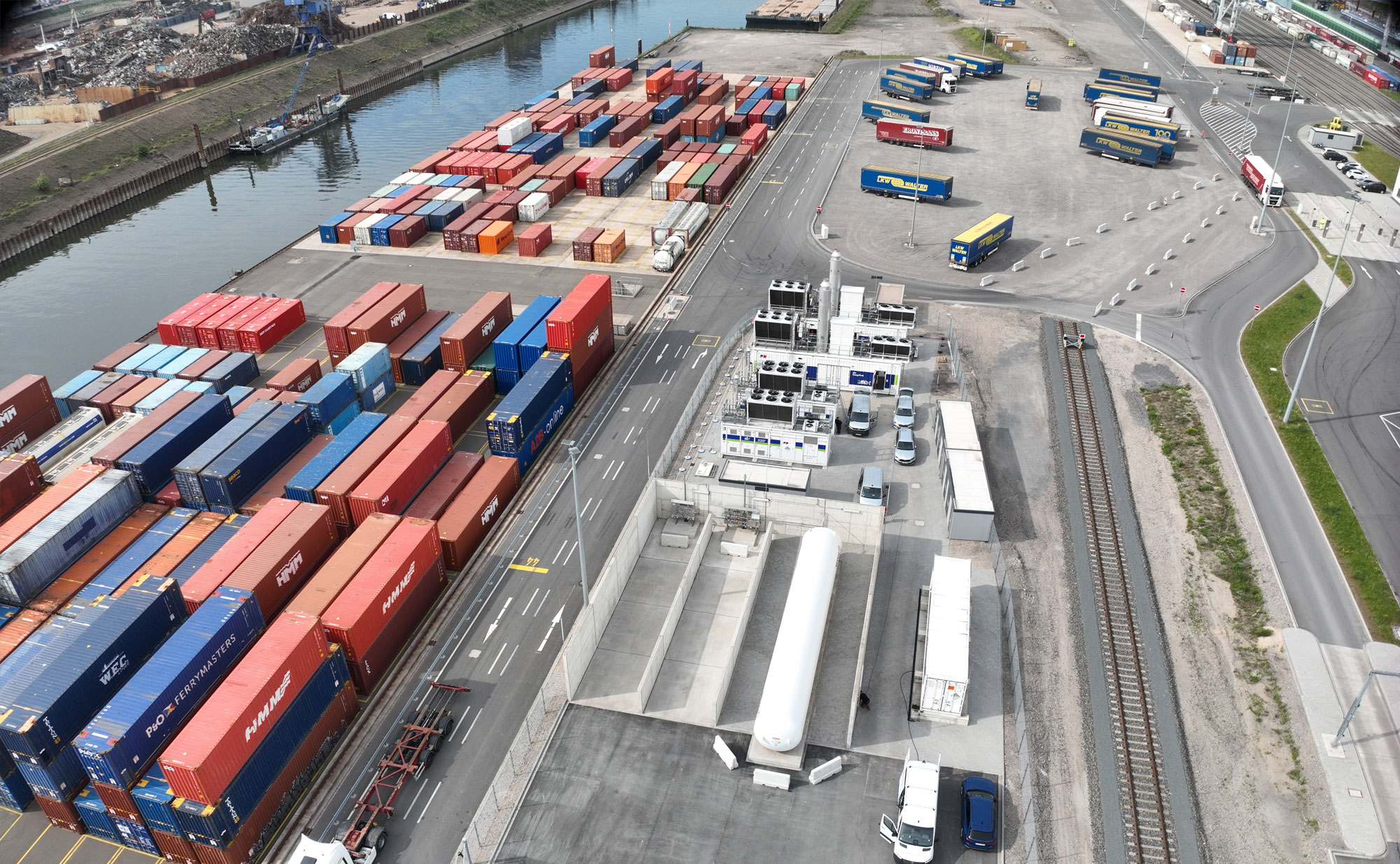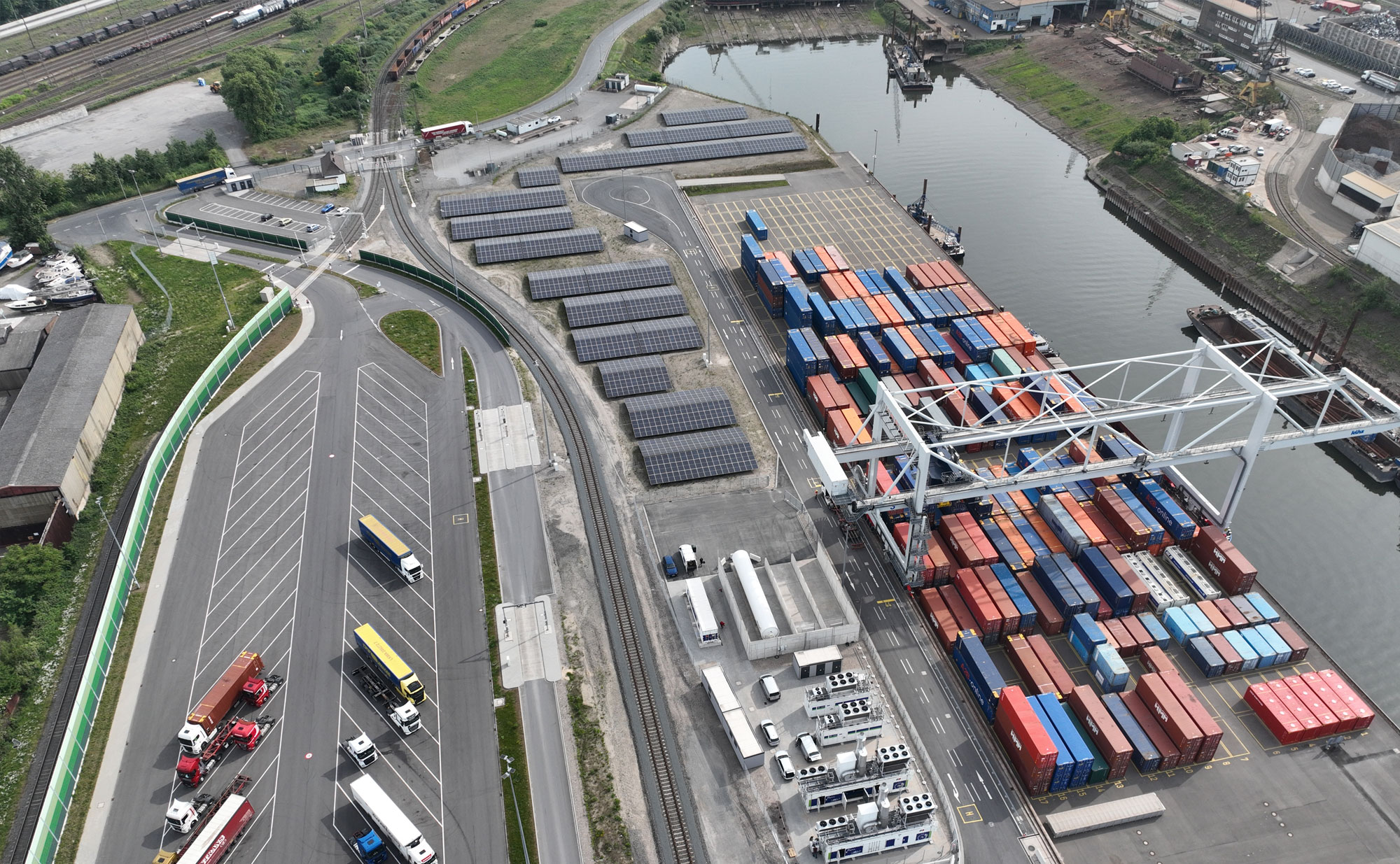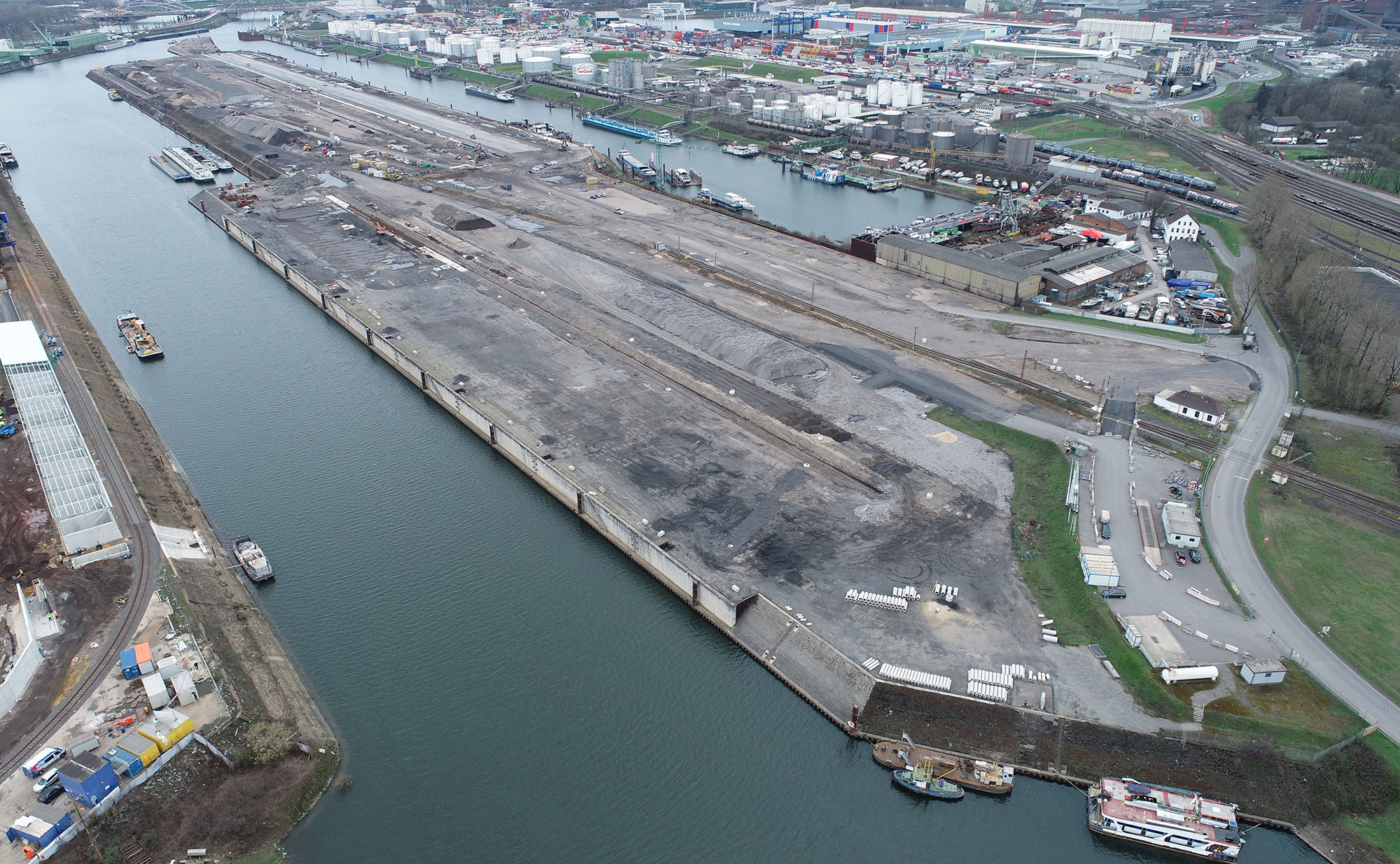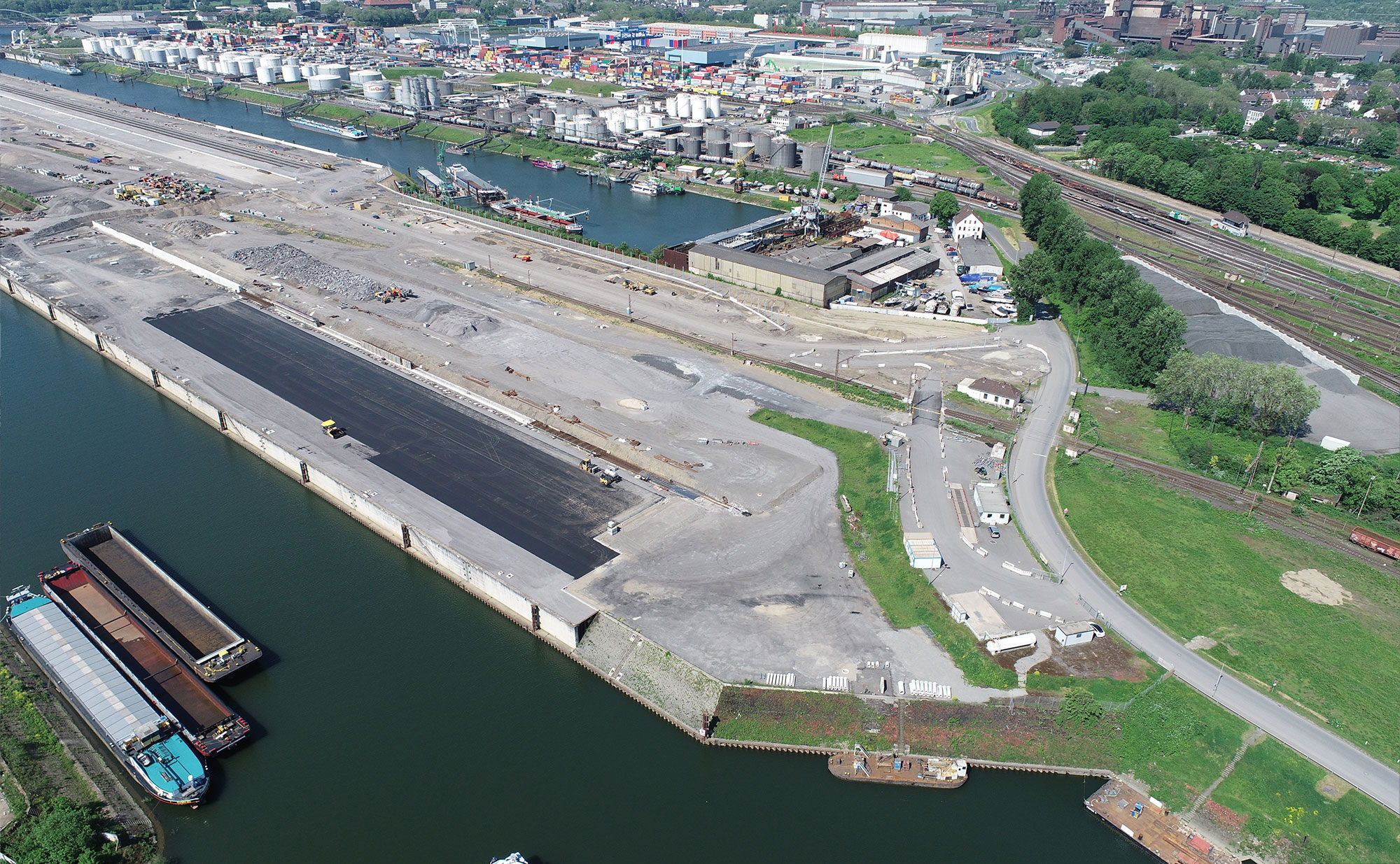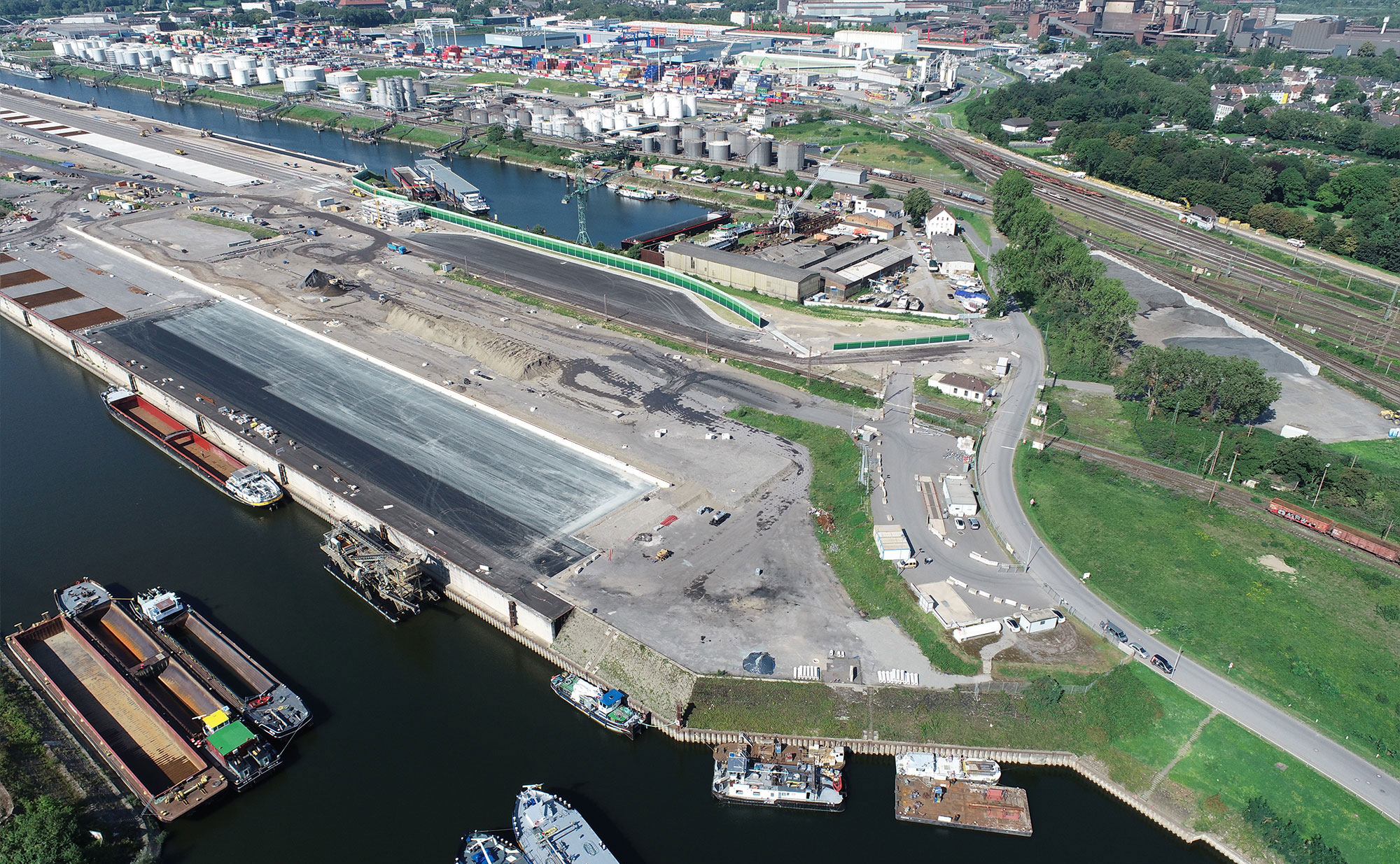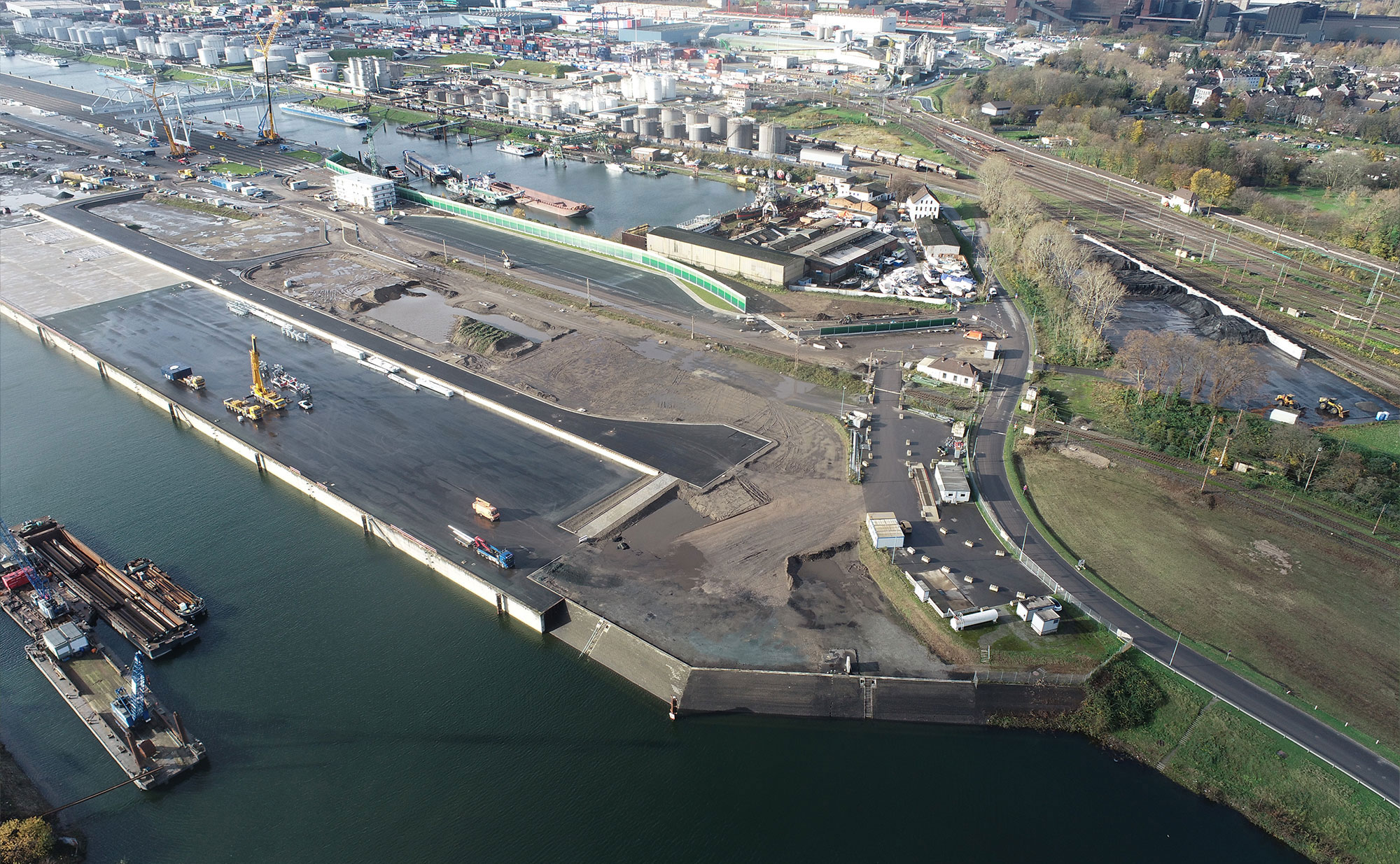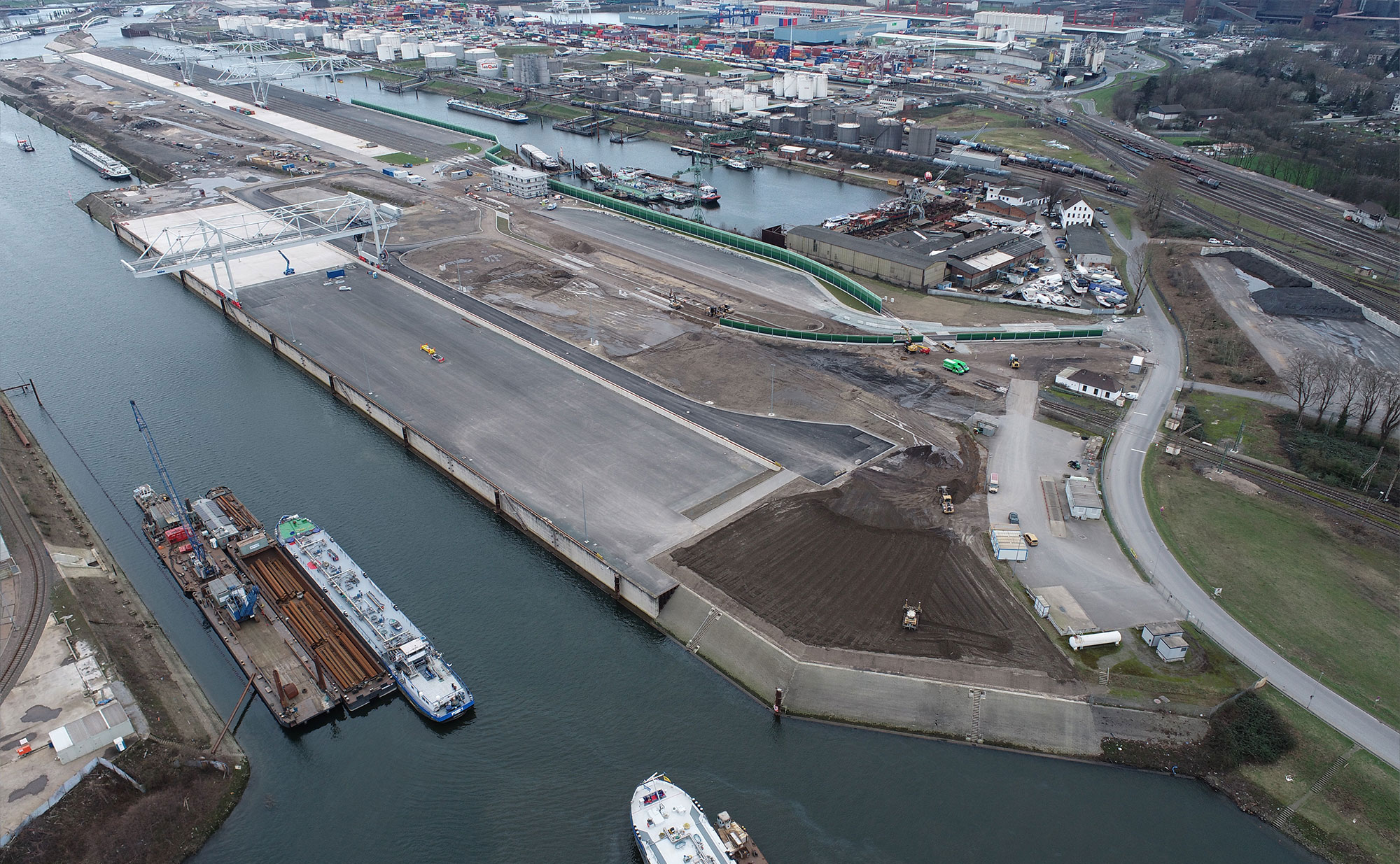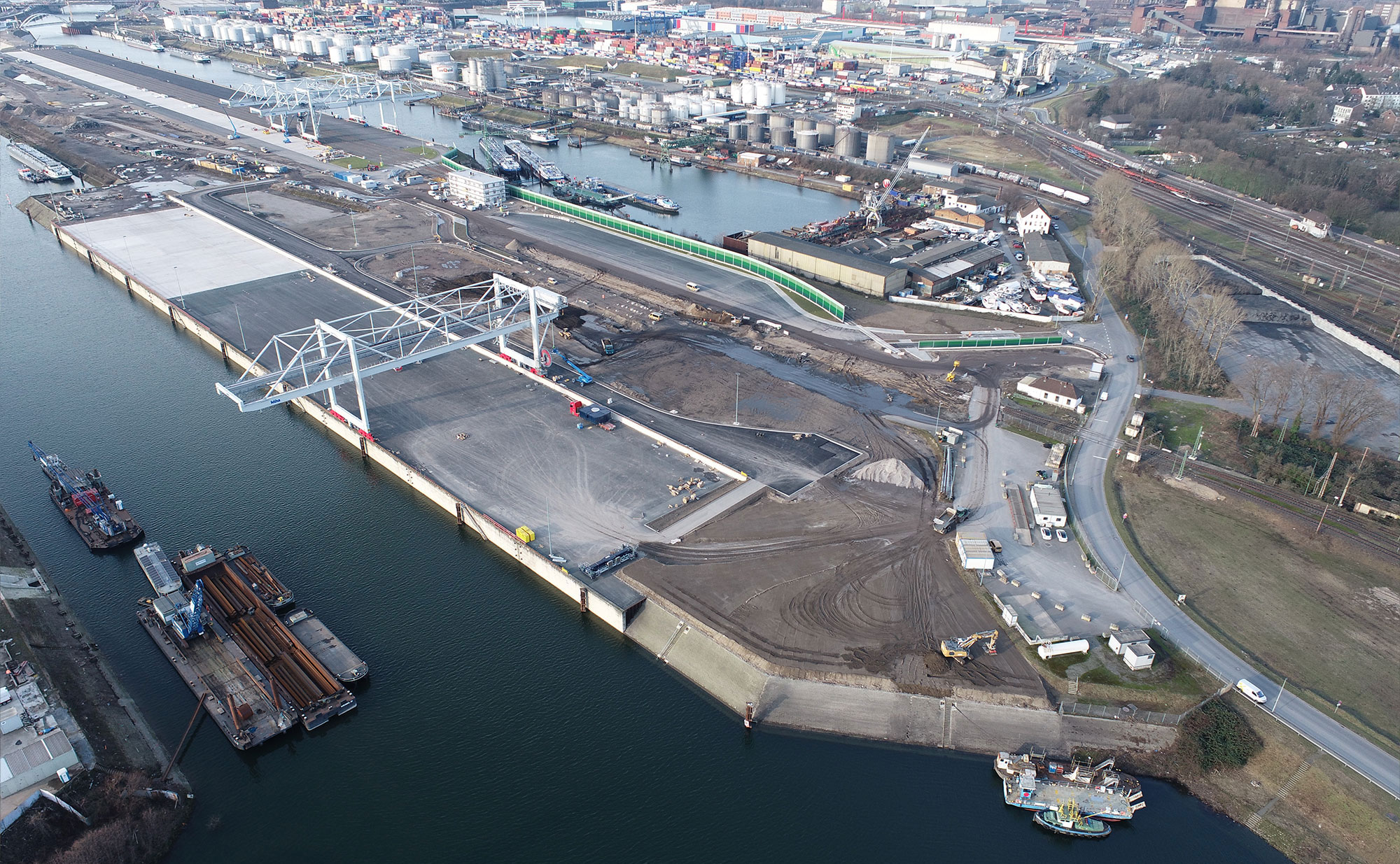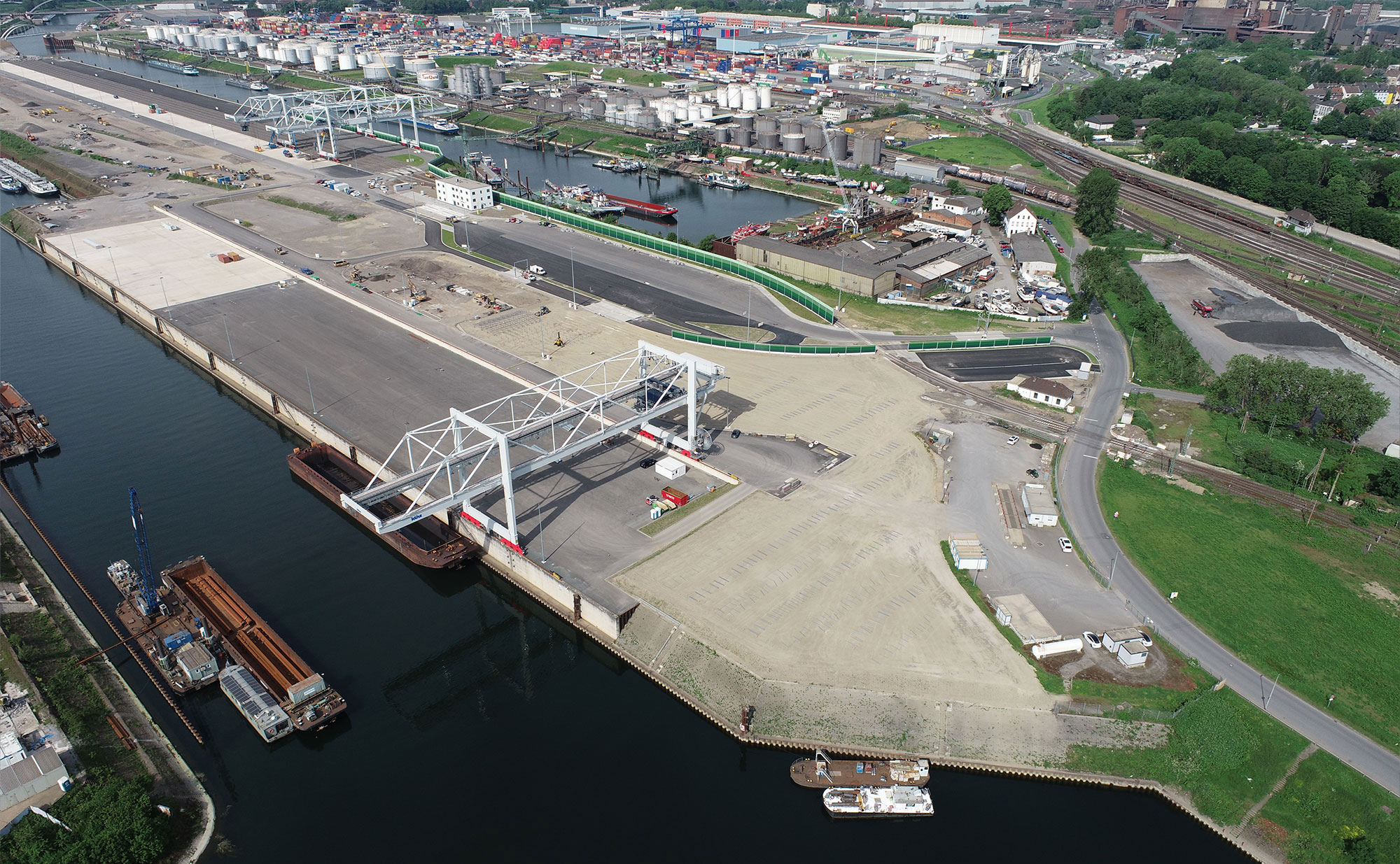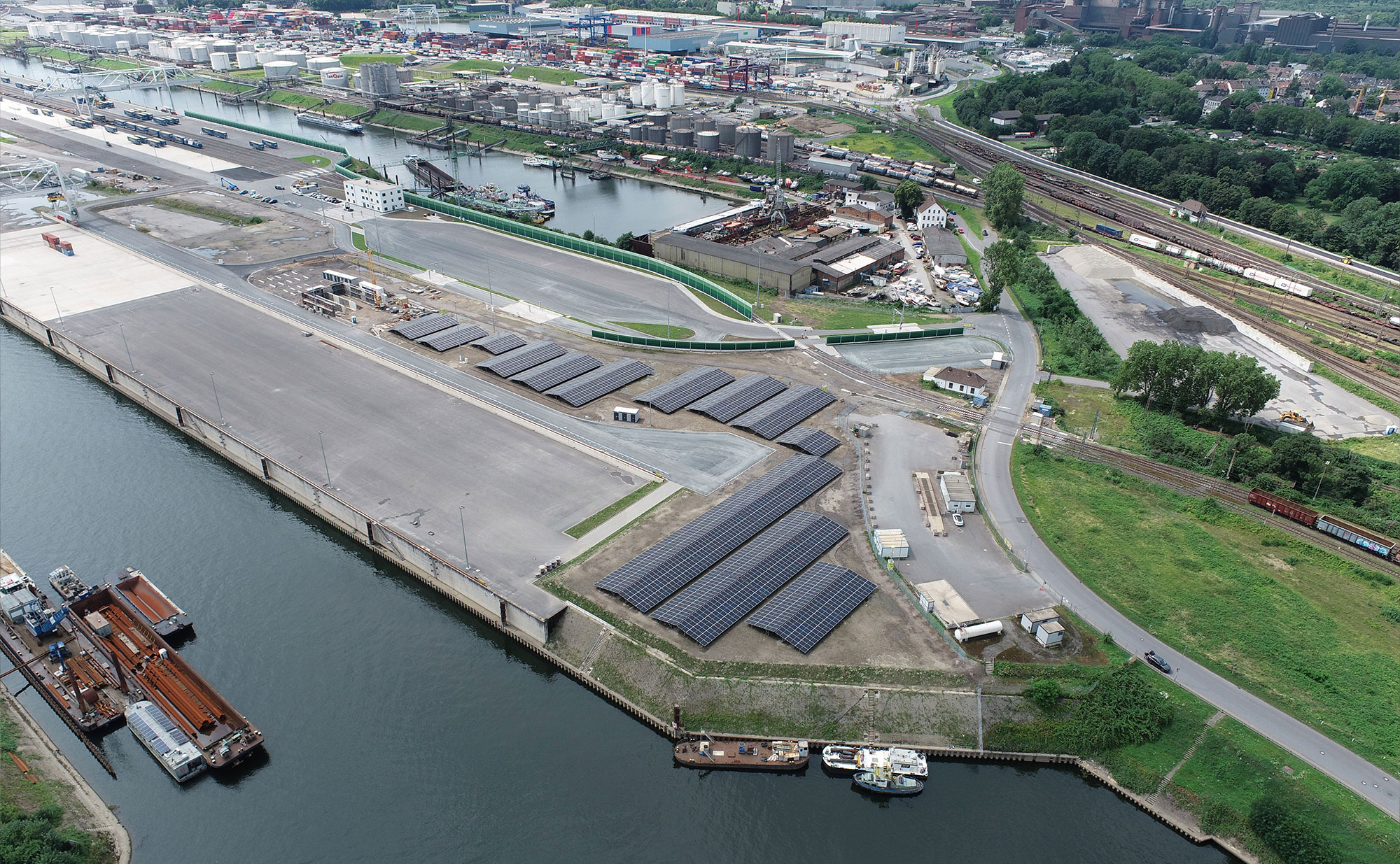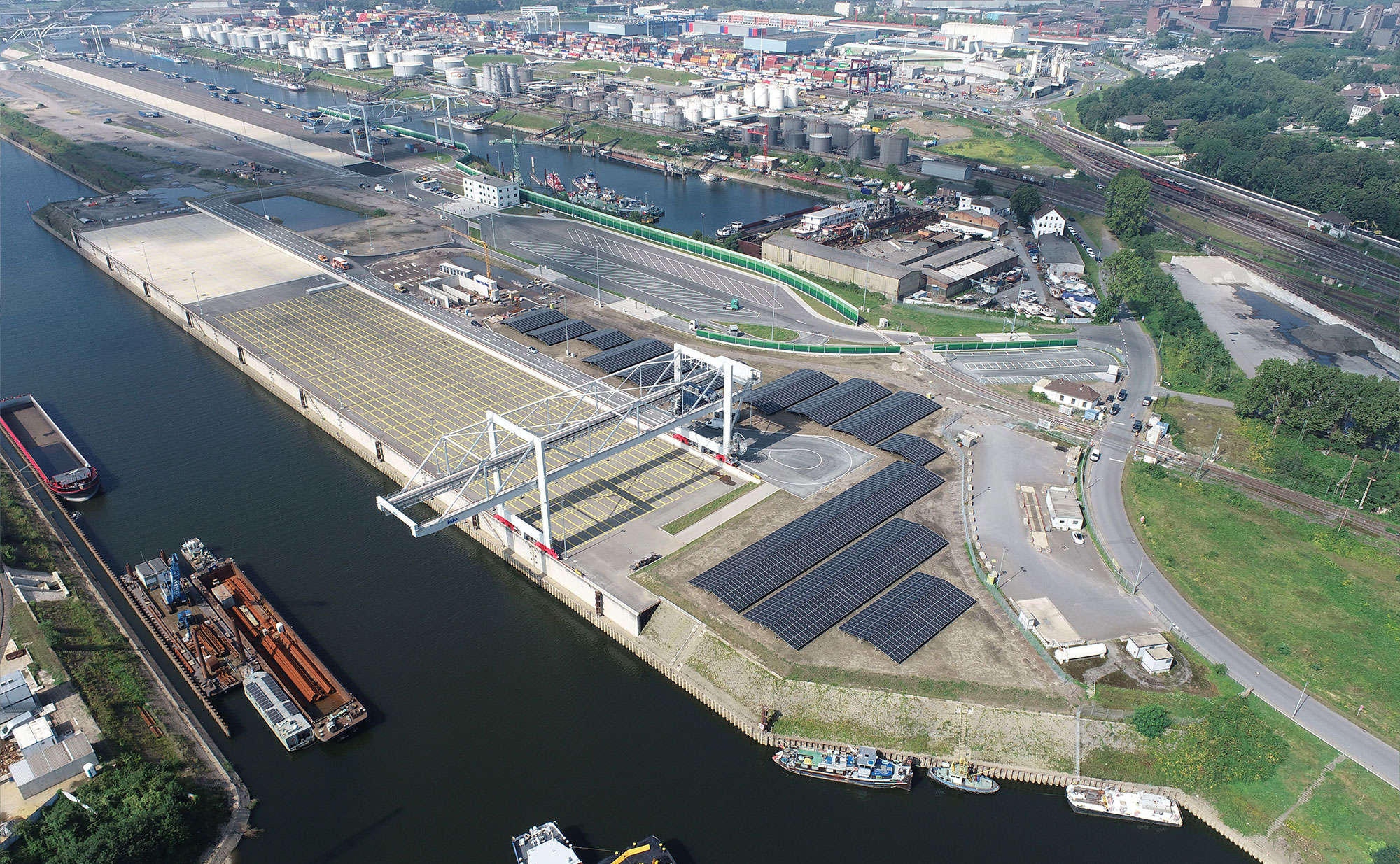enerPort II
Optimized energy use in the port microgrid @ DGT
The Duisburg Gateway Terminal (DGT), the largest container terminal in the European hinterland, is being built in the Port of Duisburg. It is the first terminal to be operated completely climate-neutral with the help of hydrogen and to be intelligently networked. We are working on this goal in the enerPort II project. We are also investigating the possibilities for supplying neighboring districts with energy in the project. Thus, the developments at the DGT are considered a model project for the future of logistics.
Termine
6. Mai 2025, Oberhausen
Hafenprojekte diskutieren in Oberhausen erneuerbare Energien und Energiesysteme >
13.-15. Mai 2024, Rotterdam
enerPort II auf dem World Hydrogen Summit >
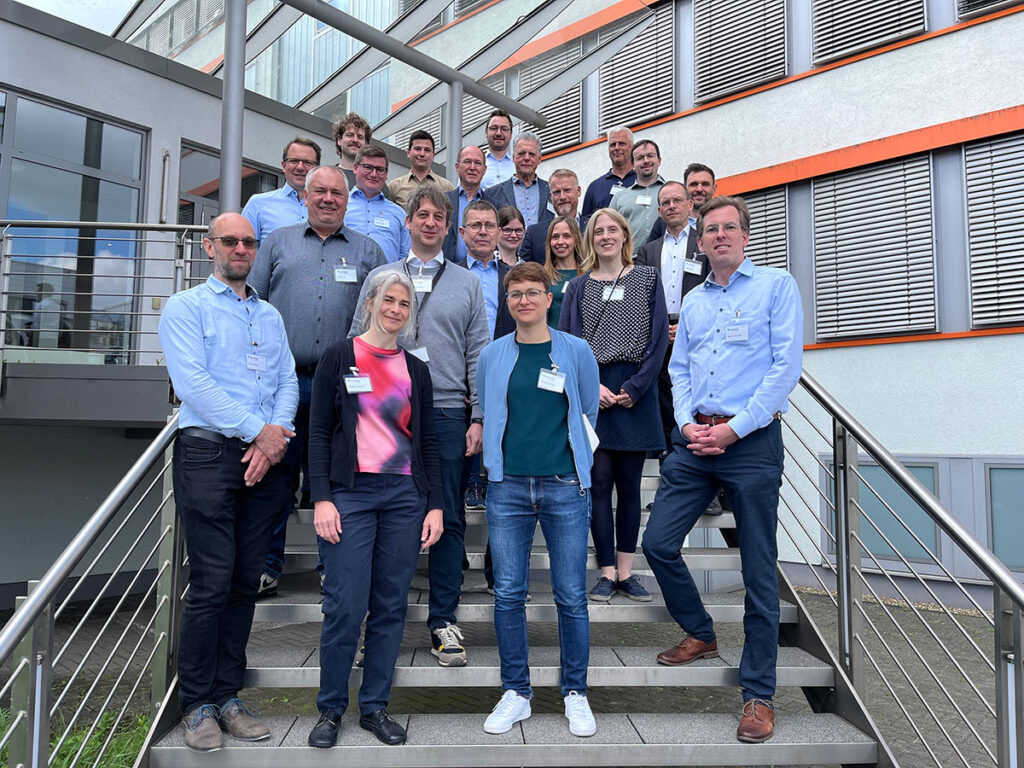
Hafenprojekte diskutieren in Oberhausen erneuerbare Energien und Energiesysteme
Am 6. Mai 2025 trafen sich verschiedene Hafen-Projekte zum Workshop „Erneuerbare Energien und neue Energiesysteme in Häfen“ in Oberhausen, um Erfahrungen bei der Umsetzung ihrer jeweiligen Vorhaben auszutauschen. Im Rahmen des Forschungsprojekts enerPort II organisierte Fraunhofer UMSICHT den Workshop in Kooperation mit der NOW GmbH sowie deren e4ports-Netzwerk.
Im Mittelpunkt der Diskussion standen die Themenfelder Projektziele, rechtliche Rahmenbedingungen, Genehmigungsprozesse sowie Betreibermodelle. Aus den Perspektiven der Projekte wurden sowohl Hemmnisse als auch Lösungsansätze zusammengetragen. Projektübergreifend konnten so zahlreiche Punkte identifiziert werden, in denen sich die komplexen Prozesse für umsetzungsorientierte Vorhaben zur Energiewende in Häfen verbessern ließen.
Im Nachgang zum Workshop wird eine gemeinsame Veröffentlichung mit Handlungsempfehlungen zur Überwindung der Hemmnisse erarbeitet. Diese Empfehlungen richten sich an die Politik, an Forschungsprojekte und an Häfen im Transformationsprozess der Energiewende. Weitere Informationen hierzu folgen.
Im Rahmen des Messeauftritts wird enerPort im Gesamtkontext Duisburger Hafen vorgestellt.
World Hydrogen Summit Halle 6 Stand C62
Sustainable energy for the Duisburg Gateway Terminal
Background of the project
The predecessor project "enerPort – Sector coupling and efficient energy supply of inland ports using the example of the Port of Duisburg" started with the conduction of a status analysis: How can inland ports be characterized? What fields of action can be identified with regard to the energy transition? And what are the requirements and framework conditions specifically at the Port of Duisburg? Based on the answers, duisport and Fraunhofer UMSICHT developed technology-open and transferable overall concepts for the energy use and supply of inland ports. They follow a cross-industrial approach to sector coupling of the energy industry with production, logistics, urban space and mobility in order to create synergies across the board and fully exploit the potential of the locations.
Zu diesem Projekt ist bereits die Metastudie
Binnenhäfen als Handlungsräume der Energiewende
erschienen
Intelligently networked · Own PV power · Flexible by hydrogen
Using the DGT as an example, the project aims to demonstrate how sustainable and system-friendly energy supply for a modern container terminal can be achieved. A local, hydrogen-based energy system will be implemented, integrating various energy conversion and storage systems to sustainably provide both electricity and heat. Additionally, there are options to couple the energy system with surrounding neighborhoods or industrial companies. In the form of concepts, it is therefore to be shown where synergy potentials exist with surrounding stakeholders, how these can be utilized and where obstacles hinder implementation. This approach contributes to developing innovative energy supply concepts at the local level, testing them in practice, and making them connectable to the surrounding area.
“Inland ports are unique urban districts with their own energy requirements. They are home to both national and international freight transportation as well as other industries and trades, and are often located close to residential areas. Their further development must therefore meet economic as well as climate and environmental protection requirements.”
Anna Grevé, Head of the Department of Electrochemical Energy Storage at Fraunhofer UMSICHT
Anna Grevé, Leiterin der Abteilung Elektrochemische Energiespeicher am Fraunhofer UMSICHT
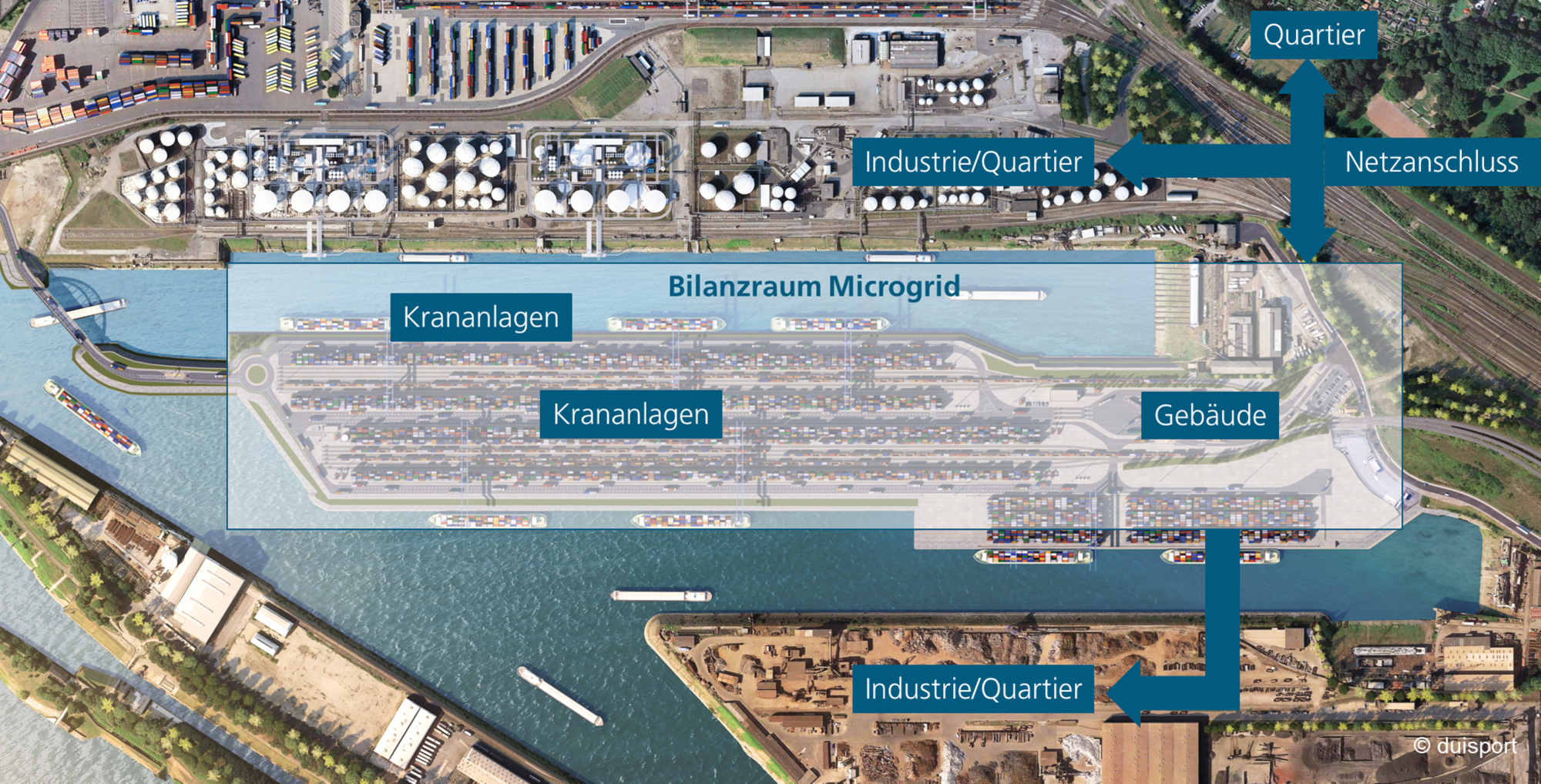
The sustainable energy supply of the terminal is to be ensured through the interaction of systems with different, complementary properties:
The sustainable energy supply of the terminal is to be ensured through the interaction of systems with different, complementary properties:
PV systems as well as hydrogen-powered combined heat and power plants (CHP) and fuel cells ensure electricity production. Some of the waste heat from the CHP units is used to heat an office building on the terminal. Additionally, there is a surplus of heat available that could also be used to supply consumers outside the DGT. By using hydrogen, the power supply can be maintained even if the PV systems produce little or no electricity. Electricity that the PV systems produce in such large quantities at times that it cannot be used directly is stored temporarily in battery storage systems. In addition, a connection to the public electricity grid guarantees security of supply.
The operation of the energy system at the terminal is adapted to the needs of crane systems, shore power supply for ships, charging stations for cars, terminal buildings, lighting and other small consumers. Various objectives can be pursued here, e.g. minimizing CO2 emissions, minimizing costs, minimizing or maximizing the amount of heat generated. Mathematical optimizations are carried out to adapt the operating strategy to the respective objective (see section “Mathematical modelling”).
“An intelligent local energy network couples and controls renewable energy systems in the form of photovoltaic and hydrogen-based combined heat and power plants with electrical and thermal energy storage systems, hydrogen storage systems and consumers such as buildings, shore power, charging stations and crane systems. The future supply of adjacent neighborhoods will also be considered conceptually.”
Alexander Garbar, Head of Corporate Development and Strategy, Duisburger Hafen AG
Alexander Garbar, Head of Corporate Development and Strategy, Duisburger Hafen AG
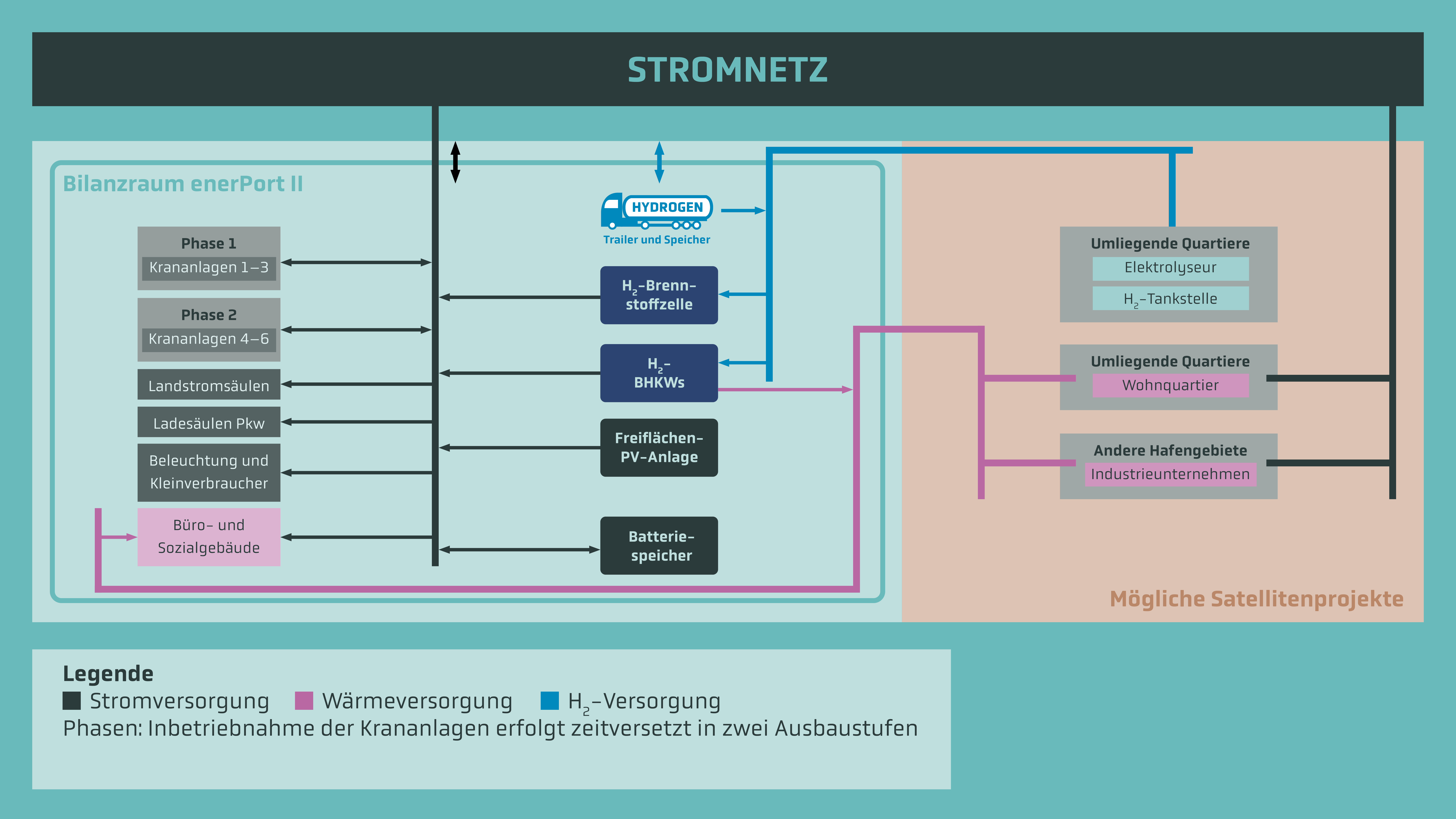
The operation of the systems in the microgrid is planned to optimize selected objectives. One objective, for example, is to cause the least possible CO2 emissions. To achieve this, power-generating systems operated with green hydrogen are used whenever the PV system does not supply electricity. However, this is also linked to questions of economic viability, as the use of green hydrogen has advantages over grid electricity in terms of CO2 emissions but also incurs higher costs due to additional necessary conversion steps (hydrogen production, hydrogen combustion).
In order to investigate the effects of different operational objectives and to determine an optimal schedule for the systems regarding a specific operational objective, the microgrid is represented in a digital-mathematical model with its boundary conditions and the associated costs. This model consists of mathematical descriptions of the operational modes of the individual systems. Subsequently, the optimal schedule is identified using intelligent algorithms, taking into account those boundary conditions and costs. By examining the schedules, it is possible to determine the resulting CO2 emissions and financial costs for an operational period.
“The digital-mathematical optimization model allows us to create operational schedules for a wide variety of situations, identify critical situations in advance and answer arising questions. In this way, the operation and even the size of the plants can be optimized for different objectives and scenarios, leading to savings in costs and emissions.”
M.Sc. Lennart Schürmann, PhD student in energy system optimization at Fraunhofer UMSICHT
M.Sc. Lennart Schürmann, Doktorand der Energiesystemoptimierung am Fraunhofer UMSICHT
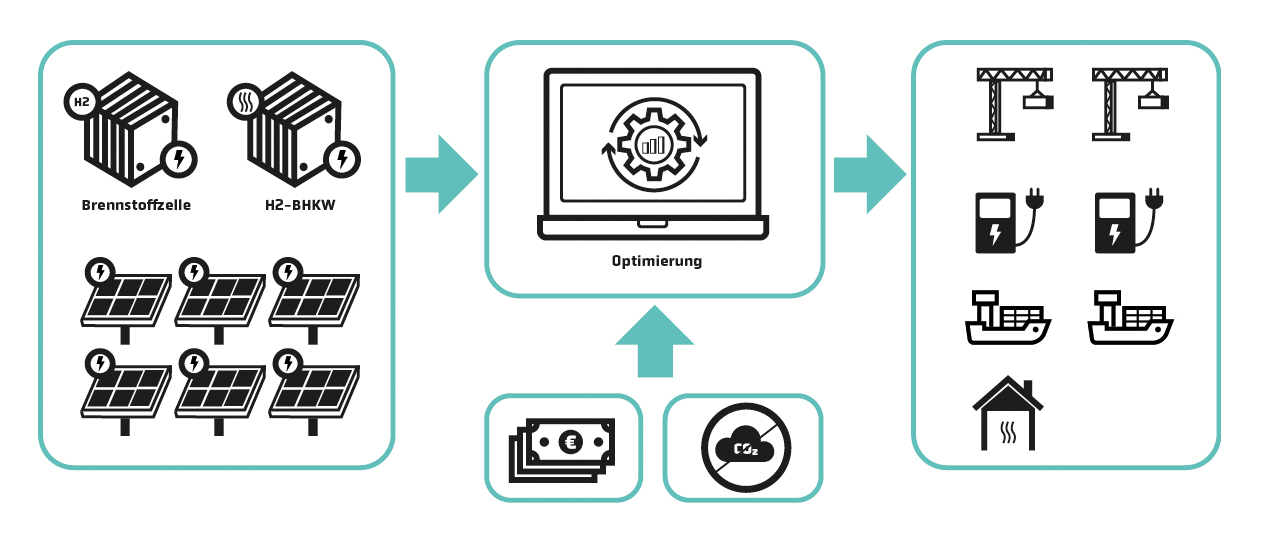
The DGT, where the microgrid will be established, is located in an area with many port facilities, companies, and commercial as well as residential areas. All people and businesses there share the same goal: to master the energy transition. They can either do this individually by modernizing their own electricity and heating supply or they can look for joint solutions where they collaborate in a way that complements each other well (synergy). Joint solutions are more efficient and better for the environment; however, larger obstacles often need to be overcome, such as regarding timelines or necessary infrastructure measures. Additionally, business models must be developed that include everyone.
enerPort II develops solutions for future connections to make the best possible use of available energy. For example, we are examining whether and how municipal or industrial heat demands in the vicinity can be met using the waste heat generated at the terminal.
The energy system at the terminal is modular in design. This allows for future expansions as needed. Transferring the system to other locations is also possible. Thus, the enerPort II energy system is an important building block for the future of decentralized energy supply.
The DGT is surrounded by industrial companies, further commercial areas, and adjacent residential areas. This offers potential for the realization of a jointly efficient energy supply.
“The optimized operation of flexible local energy systems is already a significant step in the right direction. However, even greater opportunities lie in the targeted combined supply of multiple consumers, each with their own demand profiles. This leads to efficient decentralized energy systems. The idea behind the development of concepts for neighborhood connections in enerPort II is to identify suitable ways of doing this.”
Ulrike Ehrenstein, Scientist at Fraunhofer UMSICHT
Ulrike Ehrenstein, Wissenschaftlerin am Fraunhofer UMSICHT
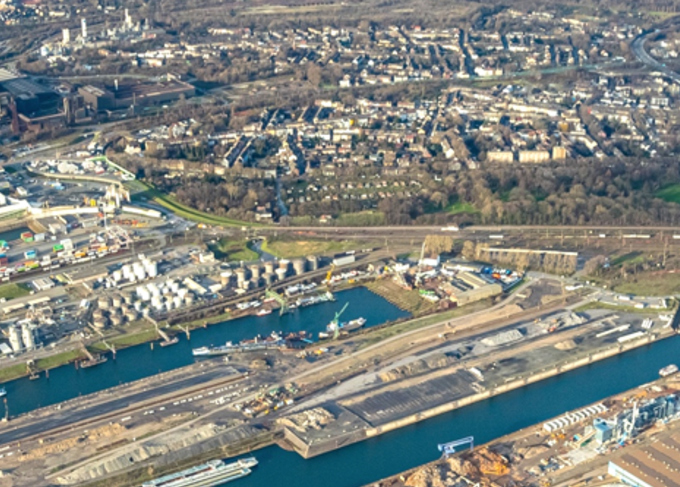
Bildergalerie Aktueller Stand
Bildergalerie Entwicklung des Terminals
Hier bewegt sich was







Die Gesamtprojektleitung liegt bei duisport. Als Eigentums- und Managementgesellschaft des Duisburger Hafens verantworten wir die Infra- und Suprastruktur sowie das Ansiedlungsmanagement für den Hafen- und Logistikstandort und bieten Full-Service-Pakete an. Ebenso erbringen wir mit unseren Tochtergesellschaften logistische Dienstleistungen, wie beispielsweise Aufbau und Optimierung von Transport- und Logistikketten, Schienengüterverkehrsleistungen, Gebäudemanagement oder Kontrakt- und Verpackungslogistik. Als weltweit größter Binnenhafen zählen wir zu den international führenden Logistik-Drehscheiben für hochwertige Güter mit hoher Wertschöpfung. Mit den direkten Verbindungen zu Zielen in ganz Europa sind wir der zentrale Hinterland-Hub für die Logistik und haben wir eine Gateway-Funktion für die zentral- und mitteleuropäischen Wirtschaftsregionen.
Die Duisburger Hafen AG ist die Miteigentümerin des Duisburg Gateway Terminal (DGT), das im Projekt enerPort II als Projektstandort dient. Im Projekt richten wir die technischen Planungen für die Installation des neuen Energiesystems an den logistischen Kernaufgaben des Terminals aus. Eine Herausforderung liegt darin, dass das DGT aufgrund seiner räumlichen Lage nur über eine limitierte Fläche verfügt und das zu entwickelnde Energiesystem mit seinen verschiedenen Komponenten eigene Platzanforderungen mit sich bringt.
www.duisport.de

Die wissenschaftliche Leitung des Projekts liegt bei Fraunhofer UMSICHT. Wir entwickeln angewandte und industrienahe Verfahrenstechnik und bringen dabei umweltschonende Technologien für ein nachhaltiges Wirtschaften im Sinne des Klima- und Umweltschutzes voran. Ein Ziel unserer Arbeit ist die intelligente und effiziente Integration erneuerbarer Energien in bestehende und neue Versorgungssysteme. Dafür erarbeiten wir sektorenübergreifende Konzepte und setzen auf cross-industrielle Kooperationen, die lokale Synergien bestmöglich ausschöpfen.
Im Projekt enerPort II gehen wir der Frage nach, wie sich Photovoltaik, Brennstoffzellen, Wasserstoff-Blockheizkraftwerke sowie zugehörige Speicher zu einem intelligenten System verknüpfen lassen. Zu diesem Zweck werden mathematische Optimierungsmodelle entwickelt, die Aufschluss darüber geben, welche Dimensionierungen und Betriebsweisen der einzelnen Systemkomponenten geeignet sind, um die geforderte Versorgungsaufgabe optimal zu erfüllen. Darüber hinaus begleiten wir das Monitoring während der Inbetriebnahme und im Pilotbetrieb.
www.umsicht.fraunhofer.de
Die Netze Duisburg GmbH ist der Verteilnetzbetreiber für das Duisburger Stadtgebiet. Ein übergeordnetes Ziel ist für uns, an Szenarien für eine zukunftsfähige Nutzung der vorhandenen Infrastruktur bzw. an deren erforderlichem Ausbau aktiv mitzuwirken. Im Projekt enerPort II gehört es zu unseren Aufgaben, herauszuarbeiten, über welche Netzinfrastrukturen der Wasserstoff auf dem Gelände des Terminals DGT verteilt werden kann. In der Rolle des Verteilnetzbetreibers untersuchen wir die mögliche Netzinfrastruktur auf Grundlage der geplanten Anlagen und Energie-Abnehmer auf dem Hafengelände. Wir konzipieren dabei die benötigte Leitungsinfrastruktur. Darüber hinaus unterstützen wir bei der Ermittlung von weiteren Akteuren in der Umgebung des Terminals, mit denen sich ggf. Synergien bezüglich der Wärme- oder Wasserstoffversorgung ergeben könnten.
www.netze-duisburg.de

Welche Rolle Wasserstoff in der zukünftigen Energieversorgung des Container-terminals spielen wird, wird Rolls-Royce zeigen. Dazu wird das Unternehmen wasserstoffbetriebene Brennstoffzellenaggregate für die Abdeckung von elektrischen Spitzenlasten sowie Wasserstoff-Blockheizkraftwerke für die elektrische Grundlast und die Wärmeversorgung installieren.
www.mtu-solutions.com

Die Stadtwerke Duisburg AG versorgen die Stadt Duisburg mit Strom, Gas, Wasser und Fernwärme. Als lokaler Versorger einer Großstadt in einem industriellen Ballungsraum gestalten wir die Energiewende im großen Maßstab mit. Auf dem Weg zu einer nachhaltigen Energieversorgung haben wir im Jahr 2018 das Steinkohlekraftwerk HKWI stillgelegt und betreiben nun ein erdgasbetriebenes Heizkraftwerk, um die Stadt Duisburg mit Fernwärme aus Kraftwärmekopplung zu versorgen. Darüber hinaus investieren wir in den Ausbau erneuerbarer Energien sowohl in Duisburg als auch in den Windkraftausbau außerhalb des Duisburger Stadtgebiets und tragen dazu bei, die Elektromobilität in Duisburg voranzubringen. Im Projekt enerPort II beteiligen wir uns an der Entwicklung einer Wasserstoffwirtschaft in Duisburg. Wir erarbeiten ein Konzept zur Errichtung eines Elektrolyseurs zur Herstellung von Wasserstoff unter Verwendung von erneuerbarem Strom und einer darüber zu versorgenden Wasserstofftankstelle. Auch sollen mögliche weitere Abnehmer identifiziert werden, um die Nachfrage nach grünem Wasserstoff zu skizzieren. Eine Versorgung des Verkehrssektors mit grünem Wasserstoff ist dabei von zentraler Bedeutung für uns.

Als flexibles und innovatives Energiehandels- und Dienst-leistungsunternehmen ist die Stadtwerke Duisburg Energiehandel GmbH Dienstleistungspartnerin für Stadtwerke und Weiterverteiler-unternehmen in Deutschland. Als 100 %ige Tochter der Stadtwerke Duisburg AG optimieren und vermarkten wir das KWK-Kraftwerksportfolio sowie EEG-Anlagen des Gesellschafters. Zudem agieren wir u. a. für den DVV-Konzern als zentraler Marktzugang für Strom, Gas und CO2 und übernehmen Dienstleistungen im Bilanzkreismanagement sowie Portfoliomanagement für weitere Kunden.
Unsere Aufgabe im Projekt enerPort II ist der Part der Schnittstelle zu den klassischen Energiemärkten und Börsenhandelsplätzen, wodurch wir einen wirtschaftlich optimalen Betrieb eines sektoren-übergreifenden Energie-systems ermöglichen. Unser Ziel ist es, alle beteiligten Akteure in einen lokalen Handelsplatz einzubinden, um der komplexen Betreiberstruktur aus Hafen, Terminalanrainern, Energieversorger, Netzbetreiber und umliegenden Quartieren eine wirtschaftliche Basis zu geben.

Mit der Westenergie Netzservice GmbH, die eine 100-prozentige Tochter der Westenergie AG ist, firmieren wir seit dem 1. April 2021 als eigenständige Gesellschaft, um schneller und flexibler am Markt agieren zu können. Wir sind europaweit tätig und entwickeln intelligente, modern und maßgeschneiderte Lösungen für die Netzinfrastruktur von Kommunen, Unternehmen, Netzbetreibern und Stadtwerken. Zu einer modernen Infrastruktur gehören nicht nur Strom- und Gasleitungen: Kommunen, Unternehmen und Netzbetreiber benötigen schnelles und stabiles Internet für zukunftsfähige Arbeitsplätze sowie Lösungen für Elektromobilität, vernetzte Quartiere, Wasserstofflösungen und den digitalen Wandel. Im Projekt enerPort II wird ein Energiemanagementsystem (EMS) benötigt, das sämtliche Komponenten des neuen Energiesystems für das Terminal DGT miteinander koppelt (Sektorenkopplung). Wir sind im Projekt dafür zuständig, dieses Managementsystem zu entwickeln und zu installieren. Ziel ist dabei die Integration von Speicher- und Erzeugungsanlagen (H2-BHKW, Brennstoffzelle, PV-Anlagen) ins Microgrid – mittels intelligenter Steuerung unter Berücksichtigung der Anforderungen des Anlagenbetriebs.
Kontakt
Bei Fragen zum Projekt oder themenspezifischem Interesse, beispielsweise an der Transformation anderer Hafenstandorte, an einzelnen Technologien oder am Zusammenspiel der Technologien im Microgrid, schreiben Sie uns gerne an:
Projektförderung
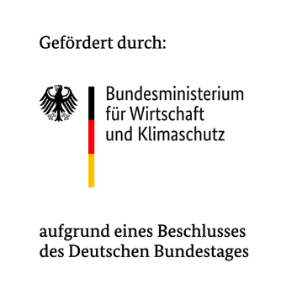
Das Projekt „Verbundvorhaben: EnEff:Stadt: enerPort II – Optimierter Energieeinsatz im Hafen-Microgrid @ DGT“ wird vom BMWK unter dem Förderkennzeichen 03EN3046 mit einer Laufzeit vom 01.12.2021 bis zum 30.11.2025 durch eine Zuwendung aus dem Sondervermögen „Energie und Klimafonds“ gefördert. Es ist auf der Seite energiewendebauen.de aufgeführt.
